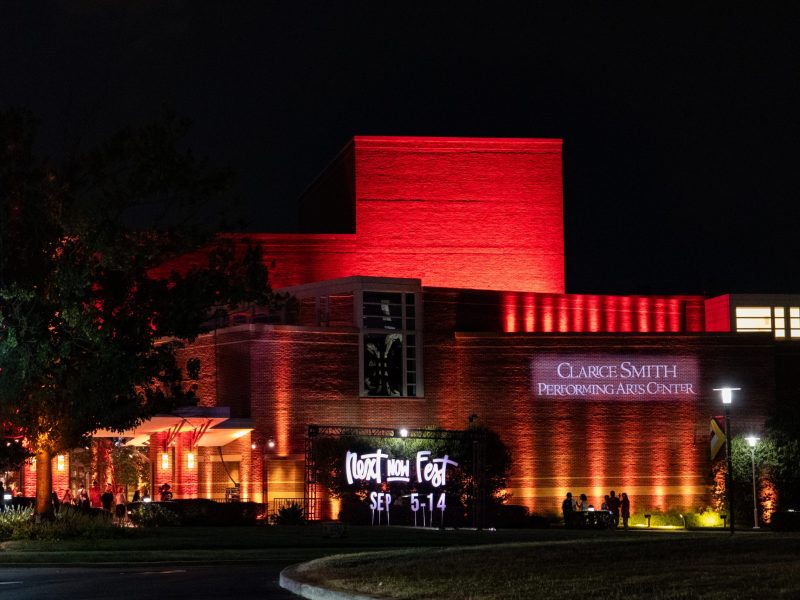There are very few halls in which Tamino, the daunting, lovestruck hero of Wolfgang Amadeus Mozart’s Die Zauberflöte (The Magic Flute), could get away with a Maryland flag bowtie.
The pleasant crisscrosses of the Calverts and outsized rounded serifs of the Crossland banner indeed seem puzzling interspersed with the fantasy elements of a not-so-defined time period featuring Egyptian gods, Enlightenment ideals and exquisitely German turns of phrase.
But in the Dekelboum Concert Hall at Clarice Smith Performing Arts Center on Friday night — as the campus rollicked into Art Attack and the Maryland Opera Studio and UMD Wind Orchestra joined for an unorthodox Zauberflöte — the bowtie worked swimmingly.
The one-off production was totally out of the ordinary and yet somehow entirely perfect. It had laughs, most notably through an expert Papageno from Anthony Eversole (fall’s titular Don Giovanni) and an all-too-fleeting Papagena from an animated Amanda Baker.
It had moments of pure beauty, from Chelsea Davidson’s Pamina (whose very portrait stole Tamino’s heart), and even the perpetually pining damen, played by Esther Maureen Kelly, Nicole Levesque and Louisa Waycott.
Most notably for an opera trumpeting the Enlightenment, it had no shortage of “hell, yeah!” moments either.
The Emanuel Schikaneder libretto, erroneously attributed to Don Giovanni librettist Lorenzo Da Ponte in the evening’s programs, is heavy-handed in its explicit morals, but with encouragement from modern companies can be shaped into a foil of morality itself.
In a stunning sequence extraordinarily prescient on college campuses, the lustful, shoulder-chipped Monostatos (Alec Feiss) is dismissed from Sarastro’s “brotherhood” when he repeatedly attempts to rape Pamina.
The Maryland Opera Studio chose to reverse the racial roles of Monostatos and his master, Sarastro (Daren Jackson, who is black and was fantastic as Leporello in the fall’s opera). I’ll tentatively say that if this wasn’t intentional, it was at least a deliberate incidental decision.
Finally, Die Zauberflöte has one of the strongest female characters in opera: the beautifully acted and impeccably sung Queen of the Night, gracing us onstage in the form of a dazzling, ruffled-black-dress-clad Laynee Dell Woodward (Don Giovanni‘s Zerlina).
She is strong but not demonized for her strength, recognized as one half of a power dynamic that cannot exist without the other, but not forced to take a man to enforce it.
She is the one female character not pining constantly for a man to hold her tight, and while she loses out in the end, Mozart endows her failed character with some of the best notes he ever put to paper.
Woodward seemed to falter in her first aria, but came back in a big way for “Der Hölle Rach,” her signature feature.
And, while the opera is a little overt in its emphasis on strict gender binary and heterosexuality, for the 1700s, it’s pretty progressive.
Man cannot rule alone, narration trumpets. Not without woman by his side, balancing him. How enlightened.
These themes were heightened and spot-lit by fantastic directing, led masterfully by Nick Olcott and executed orchestrally by Anthony Rivera and Michael Votta Jr.
This year’s opera offerings were bookended by Mozart: Don Giovanni as the leaves fell into fiery orange and Die Zauberflöte as the lovely buds of spring bloom wide.
I wrote of direction that Giovanni was too sparse, with simple costumes, lacking set and a poorly-executed lighting design. This show then, with no sets, few props and almost no costume — Woodward’s fancier dress could be seen as one — is even sparser.
But somehow it works. It transmutes in our mind. Instead of looking barren by only suggesting halfway, it suggests nothing and lets Mozart’s music prompt our imaginations to paint the picture completely.
A set of trombones become gates and henchmen. A trio of saxophones becomes a bevy of spiritual guides. The oboes become female energy and the bassoons male; the flutist becomes the titular woodwind and the entire orchestra becomes a character in the opera itself. Parts normally sung were simply played musically, with subtitles explaining the dialogue or narration absent.
This is a testament to Rivera’s special arrangement, which he wrote in a program addendum “allows greater dramatic possibilities and the opportunity for wind players to explore new aspects of performing.”
It would be easy to dismiss this laugh-inducing orchestration — chuckles erupted as French horns obliquely mimed “wild beasts” caught in the magic flute’s spell — as child-like and immature. But to do so ignores how innovative and entertaining it is.
“If the whole world had a glockenspiel,” Papageno says, for instance, as he revels in his magic bells, “we would all live in harmony.”
Does his childlike, innocent obliviousness not strike a chord with our own, even through this funniest of lines?
The opera plays on simple themes of love and enlightenment, with clearly defined morals clearly and regularly stated. Why not, then, be similarly reductive with orchestration? Strip it to the wind orchestra, a clear nod to the titular flute.
Strip away the incidental characters who crowd out that moral, leaving only the music and their messages to inform rather than distract us.
Strip away the costumes, leaving all in black — if allowing for a ruffled dress and that Maryland flag bowtie.
Clear away the clutter of tertiary characters, to the purest of music.
After all, it’s Mozart, and it works spectacularly.


